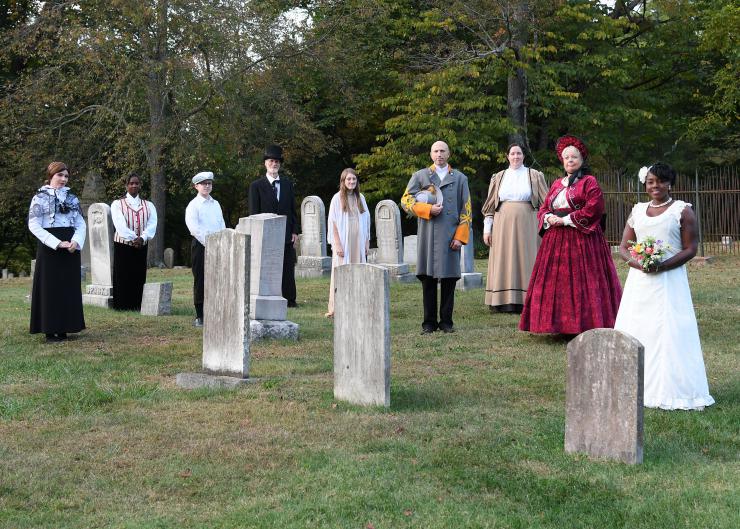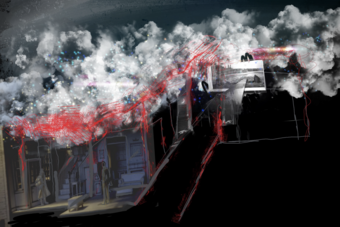Theatre Without a Theatre
On Found Spaces and Creativity in the Twin Cities
In Minneapolis and St. Paul, Minnesota, a substantial theatre community exists and thrives due to the culture and support of local communities and the state's art funding set-up. However, in spite of boasting dozens of theatre and performing arts companies of all sizes, the Twin Cities are not immune to a travesty happening in mid-sized cities around the United States: a venue shortage. Much has been reported about housing crises nationally, but as these cities go deeper into gentrification, we are also losing hundreds of actual, physical theatres nationally. In the past two years alone the Twin Cities has seen handfuls of theatres go under, not because of loss of funds or because of money mismanagement, but because rent gets overwhelmingly raised overnight, or because developers buy entire blocks and shut them down. It's a seemingly insurmountable problem, and one that I do not have the qualifications to solve. It is a problem that will likely increase if the NEA or other crucial art programs get cut, but I can't say for sure how that will go either. What I do want to discuss are the endlessly ingenious ways artists have found to work around this issue. Found spaces such as art galleries, warehouses, parks, and even garages have become hotbeds of artistic and cultural activity.
In the past two years alone the Twin Cities has seen handfuls of theatres go under, not because of loss of funds or because of money mismanagement, but because rent gets overwhelmingly raised overnight, or because developers buy entire blocks and shut them down.
In truth, the use of space in theatre has been a long time fascination of mine, likely because the use of it is not my strongest gift as a director. I have become infatuated to the point of obsession with directors who use an entire space, who find brilliant solutions to include the audience, and who take their shows out of theatre walls. One such small but fierce company is Minneapolis' own Little Lifeboats. Artistic Director Erin Denman sat down with me to discuss the perks and pitfalls of two of my favorite found spaces the company has used: a bar for Trippingly on the Tongue, a drunk version of William Shakespeare's Romeo and Juliet, and a warehouse space for the company's first full-length show, Parhelion by Abby Swafford a few years back.
The “why” of using these spaces was originally financial, as it is with most companies using found spaces. The warehouse in particular posed a number of challenges, according to Denman, including seating, lighting, and set design—three major considerations when building any show. Then there were the unexpected obstacles: warehouses don't have their own insurance, so purchasing that for a short term was costly and difficult. Most warehouse managers aren't too keen on short-term rentals, so nabbing the space for two months was a trick itself. As the company was building their show in the space, there was often loud music or other noise from neighbors in the warehouse complex. For Denman, though, the cost savings and outcome of such a beautiful show were well worth that experience.
When it came time for Trippingly on the Tongue, the company knew a bar was the right fit. Denman is a huge Shakespeare nerd (her words, not mine), and has a particular interest in making the text more accessible. The company chose Romeo and Juliet because many people know the story already, so that familiarity and the added element of having actors drinking throughout the show heightened the accessibility of the language. Furthermore, the show used the space (Sisyphus Brewing, in Minneapolis) to further draw the audience in. Juliet's famed balcony scene took place with Juliet on the bar, directly including not only the audience but the bartenders in the fun. Challenges for this space were less substantial, I was told, but noise, props storage, combat, and effective blocking did all cause the cast and crew to think harder and differently than they normally would. For these challenges, the company worked with the bar staff, and created an immersive audience experience so the audience would turn to watch the action on their own.
Denman credits both of these shows with some of her current theatrical outlook, most notably her use of spaces so intimate that the cast can see the audience's faces. Additionally, the financial reality of small theatre work means that the benefit of learning to use non-traditional spaces is its own payoff. Denman laughs as she tells me, “We melted a dimmer pack during Parhelion. If nothing else we learned that you need to spring for a designer if you're not one.”
The audience didn't feel like my show was too much or too close. They felt like they were in our story, breathing the same air as our characters, and just barely out of reach to help when tragedy struck.
While Denman and other producers fret over making these spaces work, for actors the experience is usually a thrilling challenge. Minneapolis actress Ashley Hovell was excited to work with Hero Now Theatre, a theatre specializing in found spaces, in their production of The Orestia by Aeschylus. For this production, Artistic Director Kristin Aitchison found a sculpture garden in NE Minneapolis that featured a plethora of broken stone sculptures, lending itself to the look of Ancient Greece. Says Hovell of the experience, “Aitchison chose the space because it made the set more realistic, plus the audience saw ancient and modern (background of the city) smashed together. As we know, Ancient Greek plays are still relevant today, so it was cool to see our world mixed with the ancient. As far as the experience as an actor, it really put you in that world.” Hovell didn't note any particular challenges of the experience, which is notable in its own right as the difference from producer or director to an actor when it comes to utilizing non-traditional spaces. In fact, Hovell ended her statement still in thrall about the experience: “We had real flames, you could see the moonlight, feel the bugs, hear the wind...it was really cool.” As a producer I am guessing that some of those things (the bugs!) would've been considered a challenge by other production team members, but for those bringing characters and stories to life, the challenges of the space in question often provide further character and story insight.
One of my favorite projects taking place outside of a theatre comes from outside the Twin Cities, from Jonesborough, TN. Anne G'Fellers Mason is Special Projects Coordinator at Heritage Alliance of Northeast Tennessee and Southwest Virginia. She also has an MFA in Playwriting, and had long wanted to physically put a show in a cemetery. Mason's Spot on the Hill was eventually born as a fundraiser for the local cemetery. The show is a historical piece that covers uncomfortable topics, especially in the South. Says Mason of the show:
We have an extremely dedicated volunteer who has worked for years to restore the cemetery to its appearance in the late 1800s. He also did away with the natural barriers that stood between the white cemetery and the black cemetery so that you can finally see from one to the other. This allows me to incorporate those stories and voices and to broach uncomfortable topics like slavery and segregation. … The cemetery is the perfect setting for the show, though, and not only because of ambiance, but because this is where those people are now interred. It makes you feel closer to the stories, to these people who were ordinary people doing the best they could to survive. It doesn't hurt that we perform at dusk, either, and we've had all sorts of wonderful special effects like fog, bats, and full moons.
I was excited to hear about challenges that this space created, and some of Mason's answers weren't surprising. Outdoor theatre means dealing with weather, gopher holes and uneven ground, and proper lighting for evening performances. Mason confided that they have yet to resolve the issue of sound amplification to everyone's contentment, and blocking out traffic from neighboring streets is a no-go. Then there's the unexpected challenges. The movement in the original production created a significant amount of accessibility issues, so making the play stationery was the best solution for everyone. They've even added shuttles to take to you to the spot on the hill the play takes place in.

While the use of space in theatre has always fascinated me, that fascination peaked a year ago. Gadfly Theatre Productions (where I am one of the two artistic directors) received word that not one, but two of our artistic homes would be either shutting down completely or moving to a different location opening at a far off date still to be announced. We decided to look for our own space, but finances shut down our dream art spaces pretty quickly. Instead of giving up, though, we revised our search, and ended up in a 900 square foot art gallery (with a basement) that held forty-nine people during shows. My business partner in October used every inch of the space to do a telling of Qui Nguyen's She Kills Monsters—a seemingly big show for our space and budget. We used a non-traditional set-up since we were in a non-traditional space, with pieces of a stage floor (the kind that connect together to form one medium-sized stage) scattered throughout the gallery and the forty chairs we could sell tickets to filling in the other space. The show included a five-headed dragon, seven teenagers, and multiple scenes of stage combat. The director somehow fit it all in our humble space while I stood by during rehearsals with a glorified safety checklist just to make sure everything was on the up and up.
I saw many of the challenges of working outside of a theatre firsthand for that show. For example, we quickly realized we needed a lot of lighting effects, but the electrics of the space may not hold up to a wide array of standard ellipsoidals and par cans. We very cheaply rented a light set-up that a DJ at a small club would use. This particular set-up was eight instruments, all LED. They added splashes of color and dramatic effect to a basic light plot and didn't risk our electrical system at all. The lights, the combat, and the grief present in the show practically landed on the audience's laps, creating a unique, immersive experience without changing any action or dialogue in the script.
This spring, I directed a tragedy in that same space and decided to stage it much more traditionally. Given the confines of our space, however, the cast was again practically on top of the audience for much of the play. I was nervous about this at first because I was trying to take a traditional approach, but what I saw take shape on opening was a gradual increase in wide-eyed fascination that I hadn't quite seen before. The audience didn't feel like my show was too much or too close. They felt like they were in our story, breathing the same air as our characters, and just barely out of reach to help when tragedy struck. While our decision to move into this space was primarily financial, I'm not exaggerating when I say that the creative opportunities in the gallery have changed our art and how we view telling stories forever. Our next show is six one-acts in repertory, and the six directors together have more or less settled for creating a theatre in the round for that event. A year ago the thought of doing something that intricate in such a space would have terrified me. I would have shut down the conversation immediately. After seeing creative success of our first couple of shows in the space, however, I'm excited to see how we can turn the space, ahem, around, to fit all of our needs.
Found spaces are undoubtedly challenging to use. Most of us are trained in large spaces with generally well equipped lighting and scene shops. Creating a show that takes places in the world of Dungeons and Dragons in a small art gallery leaves you without that safety net completely. This has become a necessary event in many young artists' lives as theatres close and often show no signs of re-opening. From experience, the benefits often outweigh these challenges if we let them though. Intimacy and accessibility of materials is an important throughline I've heard from everyone I talked to about using found spaces. With typical theatre education and experience, the fourth wall is stressed over and over again, literally creating an invisible but real barrier between you and the audience. Pushing your show into a warehouse, a grocery store, or a graveyard tears that barrier down, forcing performers and audiences alike to face the story and its themes head on. I would also venture that if you can create a show that works in a space that was not meant for theatre, you can create a show anywhere. The ingenuity you are forced to call on in these situations is unparalleled. There is yet another potential arts funding crisis on the horizon. There are new companies starting every day as houses with proper seating and sound equipment close with the same frequency. Yet theatre has always and will always remain—only now, we're coming to a storefront near you.









Comments
The article is just the start of the conversation—we want to know what you think about this subject, too! HowlRound is a space for knowledge-sharing, and we welcome spirited, thoughtful, and on-topic dialogue. Find our full comments policy here